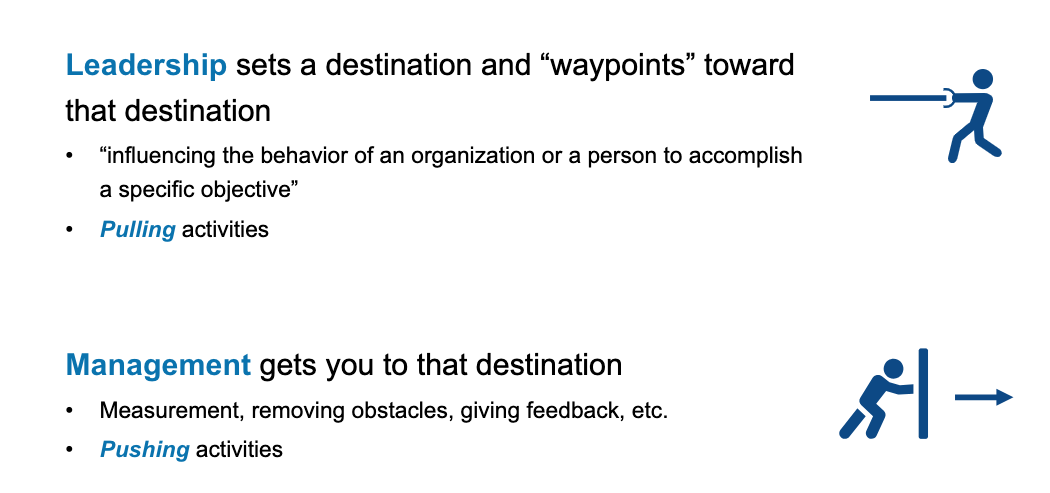
Leadership has been studied, dissected, and redefined countless times throughout history. Various models attempt to categorize different leadership styles, but two that often emerge in discussions are Transformational Leadership and Transactional Leadership. While both have their merits, a strong argument can be made that transformational leadership isn’t just another leadership style—it is, quite simply, what good leadership looks like. On the other hand, transactional leadership is less about leadership in the purest sense and more about management—a structured, hierarchical approach that focuses on maintaining order as opposed to inspiring excellence.
With the rise in popularity of Transformational Leadership, we will discuss how perhaps inadvertently – Transactional Leadership has become a prerogative term – and in doing so devalued critical elements of management discipline that are needed to actually successfully execute any transformational vision.
The Nature of Leadership vs. Management
Before delving into transformational and transactional leadership, it's important to clarify the distinction between leadership and management. Leadership is about vision, inspiration, and guiding others toward a meaningful goal, whereas management is about organization, structure, and efficiency. Leaders innovate, challenge the status quo, and create cultures of motivation. Managers, on the other hand, enforce policies, maintain productivity, and ensure processes are followed.
In short, Leadership centers around Pulling activities whereas Management is more akin to Pushing activities.

While both leadership and management are crucial for any organization’s success, leadership is about people and progress, while management is about processes and control. This distinction helps frame the fundamental differences between transformational and transactional leadership styles.
Transformational Leadership: The Definition of True Leadership
Transformational leadership is rooted in inspiration, motivation, and long-term vision. It is a leadership style that focuses on empowering and developing followers, encouraging innovation, and fostering an organizational culture that thrives on continuous improvement.
Key Characteristics of Transformational Leadership
- Inspirational Motivation – Transformational leaders articulate a clear and compelling vision that inspires others to commit to a shared purpose. This is the most critical foundation of reaching transformative objectives.
- Intellectual Stimulation – They challenge conventional thinking, encourage problem-solving, and promote creativity.
- Individualized Consideration – They take the time to mentor, develop, and empower their team members.
- Idealized Influence – They lead by example, demonstrating high moral and ethical standards, which earns them the trust and respect of their followers.
Transformational leaders build high-performing, engaged teams by instilling a sense of purpose in their employees. They focus on long-term success, nurturing their people rather than just managing outputs. It’s no coincidence that some of history’s greatest leaders—figures like Martin Luther King Jr. and Nelson Mandela—demonstrated transformational leadership qualities. Their ability to inspire and elevate others is what defined them as leaders rather than mere managers.
Transformational leaders often use concepts like Objectives and Key Results (OKR's) to connect a longer term compelling vision of the future to concrete near and medium term measurable objectives to help drive real progress. OKR's operationalize the big vision and can help build the connective tissue that builds trust and inspires teams. Transformational leaders are advocates and evangelists of using practices like OKRs while Transactional leaders primarily drive towards binary objectives and dates that lack the connection to a longer term motivating vision of the future.
Transactional Leadership: Classic Management in Disguise
While transformational leadership is about growth and inspiration, transactional leadership is more about structure, rewards, and compliance. This leadership style relies heavily on a give-and-take system, where employees are rewarded for following instructions and meeting performance expectations. It is highly hierarchical, emphasizing efficiency and clear roles over inspiration and vision.
Key Characteristics of Transactional Leadership
- Contingent Rewards – Employees are rewarded based on performance and compliance with established goals.
- Management by Exception (Active and Passive) – Leaders intervene only when performance deviates from expectations. Active management involves closely monitoring performance, while passive management waits until problems arise before intervening.
- Emphasis on Structure and Order – Transactional leaders focus on maintaining stability, predictability, and efficiency within the organization.
- Short-Term Focus – The primary goal is to meet immediate targets and maintain operational consistency, rather than fostering long-term growth or innovation.
While transactional leadership is often effective in certain environments—particularly in industries requiring strict compliance, such as manufacturing, military, or law enforcement—it does not embody true leadership. It is, at its core, an approach to managing people and task, not inspiring them to achieve greatness.
Why Transformational Leadership is Just Good Leadership
At its heart, transformational leadership aligns more naturally with the essence of leadership itself. Here’s why transformational leadership is not just another style, but the very definition of good leadership:
- Creates a Motivated Workforce – Unlike transactional leadership, which relies on external motivation (rewards and punishments), transformational leadership fosters intrinsic motivation. Employees are driven by a sense of purpose, autonomy, and growth.
- It Encourages Innovation and Adaptability – In today’s rapidly changing business landscape, organizations need agile, forward-thinking leaders who can navigate uncertainty and inspire innovation. Transformational leadership is designed for long-term success.
- It Builds Stronger Relationships – Transformational leaders cultivate deep, trust-based relationships with their teams. Employees feel valued and empowered, leading to higher engagement and loyalty.
- It Drives Long-Term Success – While transactional leadership may yield short-term gains by ensuring compliance and efficiency, transformational leadership builds sustainable growth by investing in people. Organizations led by transformational leaders are more likely to remain competitive in the long run.
- It Transforms Organizations and Societies – History has shown that the most impactful leaders—the ones who create lasting change—are transformational. They do not merely maintain systems; they redefine them, uplift people, and challenge the status quo.
When Transactional Leadership is Needed and Why it Should NOT be one or the other
Despite its limitations, transactional leadership does have its place in certain contexts. Organizations that require strict procedures, consistency, and risk mitigation — such as finance, military, or emergency response teams – may need a stronger dimension of transactional management throughout the organization. However, even in these contexts, a balance between transactional and transformational leadership is still ideal and visionary leadership is no less important to achieving difficult objectives.
For instance, an effective CEO or senior leader might employ transactional strategies for routine operational tasks while using transformational leadership to inspire vision and cultural growth. And this brings us back to our initial thesis - elements that are closely associated with Transactional Leadership are needed on any ongoing business that cares about execution.
Here are just a few examples of transactional leadership type activities and policies that are of value to most scaled organizations on an ongoing basis:
- Having a strong Incident Management process that is consistently followed, measured and reviewed
- Tying a bonus payout to completing an activity (e.g. you are paid your bonus based on achieving business objective outcomes, but you must also complete quarterly HR training to receive your payout)
- Consistently conducting (and tracking, documenting, etc.) more rigorous Architecture Reviews based on assessed business impact/risk criteria for a significant new piece of functionality
The Verdict: Leadership requires transformation driving qualities, but Executing on a Vision Requires BOTH
When evaluating what true leadership looks like, it’s clear that transformational leadership isn’t another approach—it’s the embodiment of effective leadership.
While transactional leadership serves a functional purpose, it aligns more closely with management techniques rather than true leadership. Great leaders don’t merely enforce rules and maintain order; they inspire, challenge, and elevate those around them.
In short, leadership is about driving people toward a shared vision and making a meaningful impact, and therefore transformational leadership qualities are the foundation. However, in addition to inspiring and motivating, dimensions of Transactional Leadership are critical to effective execution towards a vision and should not be considered ‘second class citizens’ or an out-of-style negative concept.
An important consideration in balancing vision and inspiration with execution is that not all leaders have the optimal balance of these qualities and behaviors. It’s no surprise that not all people that are great at inspiration are also great at managing the process and details to actually get $h%t done. Therefore, in the real world, it’s critical that leaders and their leaders are aware of their capabilities across the vision to execution cycle. It’s not expected to be optimally good at both ends of the spectrum BUT a good leader must truly understand their own capabilities across the vision to execution cycle and build a team around them that compliments the areas based on their own- strengths and gaps. For example, self-aware strong transformational leaders that are less skilled at process, operations and detailed program management, will be more successful with a strong Program Management/Operations Excellence and/or Chief of Staff team members. Some of these roles are devalued or not present in some organizations for any number of cultural or historical reasons. Therefore, a leader that understands they need to supplement their strengths with process, operations and/or execution skills, should pick the role(s) and title(s) based on the norms within their organization.
In summary, Leadership and Management concepts and their associated vernacular ebb and flow over time. What stays constant are the underpinnings of actions and behaviors that make great leaders and the capabilities that can really turn a transformational vision into successful execution that drives business success.
Following are key take aways to guide this balance:
- Know your own strengths and weaknesses and weaknesses as a leader (Transformational leadership). To lead you must be capable of evoking the emotion and commitment of the team to inspire the team towards a vision by taking concrete steps towards that vision every day.
- Assess honestly your capabilities to drive the appropriate level of disciplined execution as well as discipline in ongoing foundational operation processes (closely aligned with Transactional leadership concepts).
- Supplement your leadership and broader team where needed on any of the above critical capabilities, especially regarding execution and operations, i.e. the Leader must be able to deliver on the key aspects of Transformational leadership but may be able to supplement their weaknesses on the more Transactional management side.
Remember that doing the basics well is what gives the team autonomy to innovate and take appropriate risks to drive the product forward.
And NEVER forget as a leader YOU are fully accountable for failures and mistakes etc. - while fully crediting your team for any and all successes!
We work with successful product technology organizations to improve their technical and organizational capabilities, including executive coaching, with 100's of organizations for 15+ years. Call us and we can help!